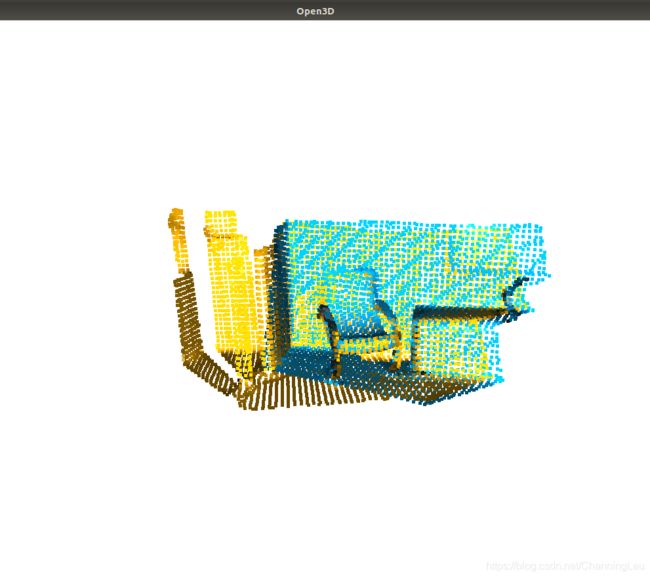3D点云全局注册RANSAC算法Python实现
3D pointcloud global registration RANSAC 算法的python实现,除了基本的库函数外,没有实现现成的RANSAC函数。Python实现这个算法运行效率特别低,跑起来很慢,效果也没能比得上库函数。下面附上效果图和代码:
import cv2
import open3d as o3d
from matplotlib import pyplot as pyplot
import numpy as np
import copy
import scipy
from scipy import spatial
import random
import sys
import math
#Kabsch Algorithm
def compute_transformation(source,target):
#Normalization
number = len(source)
#the centroid of source points
cs = np.zeros((3,1))
#the centroid of target points
ct = copy.deepcopy(cs)
cs[0] = np.mean(source[:][0]);cs[1]=np.mean(source[:][1]);cs[2]=np.mean(source[:][2])
ct[0] = np.mean(target[:][0]);cs[1]=np.mean(target[:][1]);cs[2]=np.mean(target[:][2])
#covariance matrix
cov = np.zeros((3,3))
#translate the centroids of both models to the origin of the coordinate system (0,0,0)
#subtract from each point coordinates the coordinates of its corresponding centroid
for i in range(number):
sources = source[i].reshape(-1,1)-cs
targets = target[i].reshape(-1,1)-ct
cov = cov + np.dot(sources,np.transpose(targets))
#SVD (singular values decomposition)
u,w,v = np.linalg.svd(cov)
#rotation matrix
R = np.dot(u,np.transpose(v))
#Transformation vector
T = ct - np.dot(R,cs)
return R, T
#compute the transformed points from source to target based on the R/T found in Kabsch Algorithm
def _transform(source,R,T):
points = []
for point in source:
points.append(np.dot(R,point.reshape(-1,1)+T))
return points
#compute the root mean square error between source and target
def compute_rmse(source,target,R,T):
rmse = 0
number = len(target)
points = _transform(source,R,T)
for i in range(number):
error = target[i].reshape(-1,1)-points[i]
rmse = rmse + math.sqrt(error[0]**2+error[1]**2+error[2]**2)
return rmse
def draw_registrations(source, target, transformation = None, recolor = False):
source_temp = copy.deepcopy(source)
target_temp = copy.deepcopy(target)
if(recolor): # recolor the points
source_temp.paint_uniform_color([1, 0.706, 0])
target_temp.paint_uniform_color([0, 0.651, 0.929])
if(transformation is not None): # transforma source to targets
source_temp.transform(transformation)
o3d.visualization.draw_geometries([source_temp, target_temp])
def pc2array(pointcloud):
return np.asarray(pointcloud.points)
def registration_RANSAC(source,target,source_feature,target_feature,ransac_n=3,max_iteration=100000,max_validation=100):
#the intention of RANSAC is to get the optimal transformation between the source and target point cloud
s = pc2array(source) #(4760,3)
t = pc2array(target)
#source features (33,4760)
sf = np.transpose(source_feature.data)
tf = np.transpose(target_feature.data)
#create a KD tree
tree = spatial.KDTree(tf)
corres_stock = tree.query(sf)[1]
for i in range(max_iteration):
#take ransac_n points randomly
idx = [random.randint(0,s.shape[0]-1) for j in range(ransac_n)]
corres_idx = corres_stock[idx]
source_point = s[idx,...]
target_point = t[corres_idx,...]
#estimate transformation
#use Kabsch Algorithm
R, T = compute_transformation(source_point,target_point)
#calculate rmse for all points
source_point = s
target_point = t[corres_stock,...]
rmse = compute_rmse(source_point,target_point,R,T)
#compare rmse and optimal rmse and then store the smaller one as optimal values
if not i:
opt_rmse = rmse
opt_R = R
opt_T = T
else:
if rmse < opt_rmse:
opt_rmse = rmse
opt_R = R
opt_T = T
return opt_R, opt_T
#used for downsampling
voxel_size = 0.05
#this is to get the fpfh features, just call the library
def get_fpfh(cp):
cp = cp.voxel_down_sample(voxel_size)
cp.estimate_normals()
return cp, o3d.registration.compute_fpfh_feature(cp, o3d.geometry.KDTreeSearchParamHybrid(radius=5, max_nn=100))
if "__name__" == "__main__":
source = o3d.io.read_point_cloud('global_registration/r1.pcd')
target = o3d.io.read_point_cloud('global_registration/r2.pcd')
#if we want to use RANSAC registration, get_fpfh features should be acquired firstly
r1, f1 = get_fpfh(source)
r2, f2 = get_fpfh(target)
R, T = registration_RANSAC(r1,r2,f1,f2)
#transformation matrix is formed by R, T based on np.hstack and np.vstack(corporate two matrices by rows)
#Notice we need add the last row [0 0 0 1] to make it homogeneous
transformation = np.vstack((np.hstack((np.float64(R), np.float64(T))), np.array([0,0,0,1])))
draw_registrations(r1, r2, transformation, True)


